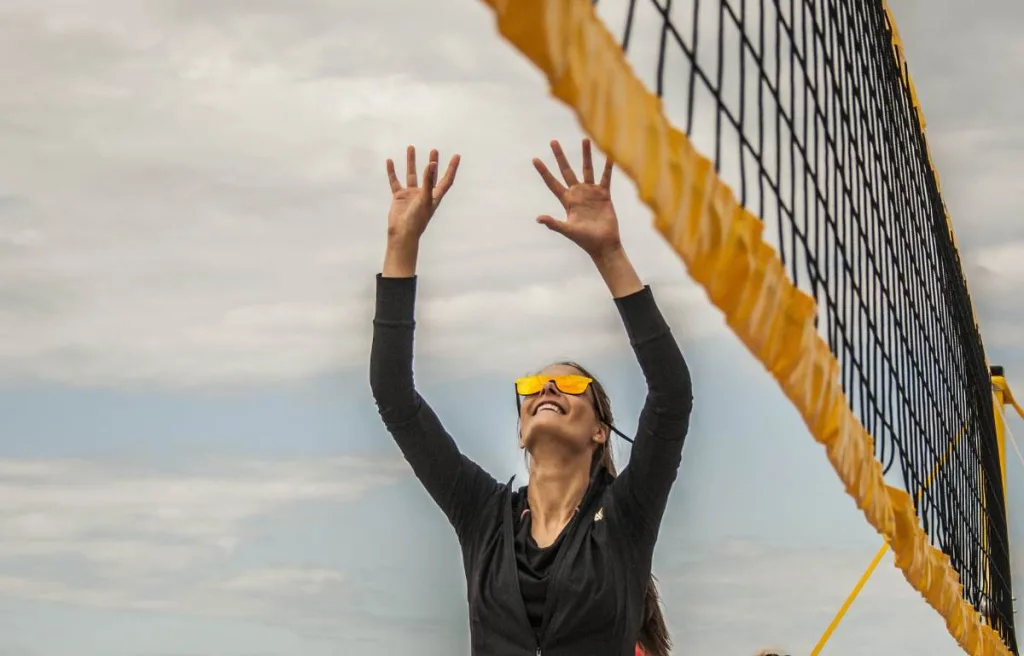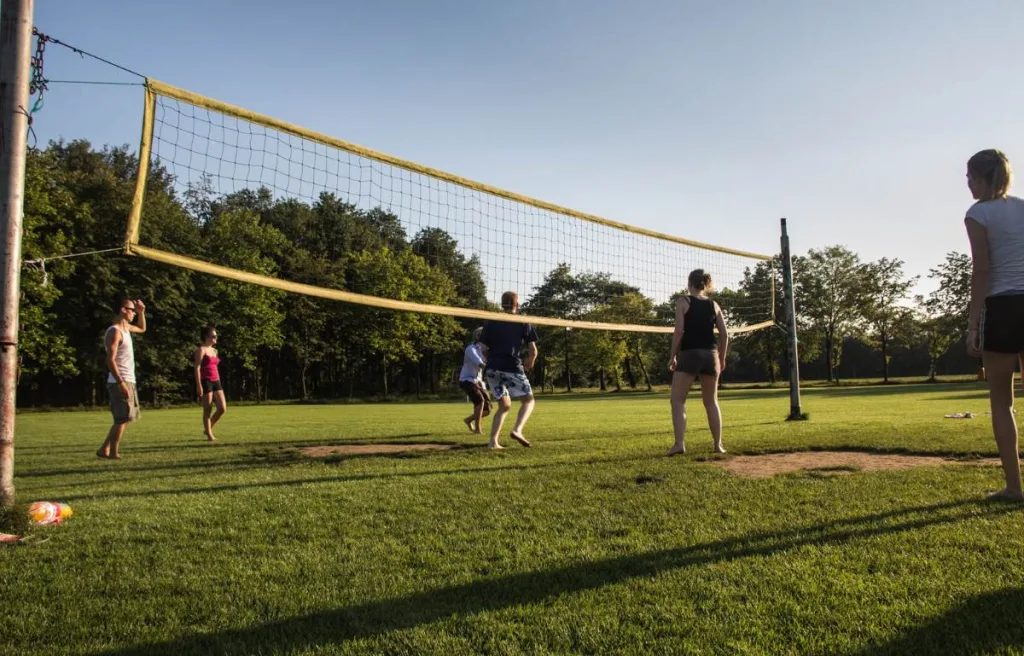Coed Volleyball: Rules and Excitement in Mixed Team Play

Imagine going to a volleyball court, and you feel the excitement in the air.
The energy of both men and women ready to compete and collaborate.

This is coed volleyball, where everyone gets to mix it up and show their stuff.
Quick Answer: Coed Volleyball, or mixed volleyball, is a match format involving three men and three women on each side. It typically follows standard volleyball rules with key variations, such as equal gender representation on the court, specific rotation systems, and adjusted net heights.
In this guide, I will explain the unique rules of coed volleyball and show its benefits and challenges.
I will discuss how this game changes from the indoor court to the sandy beach and the required adjustments that need to be made.
Additionally, I will add a bit of a twist by revealing its interesting variations, such as reverse coed and doubles.
By the end, you’ll have a complete picture of what makes this volleyball format enjoyable and inclusive.
What is Coed Volleyball?
Coed Volleyball originated in Montgomery County in 1981, even before the recognition of boys’ volleyball as a varsity sport.
Initially, it was popular among eighth graders in gym classes and after-school programs.
This volleyball format offers a unique twist to the traditional game by blending different genders into one team.
It involves an equal or balanced representation of men and women on each team, encouraging a diverse playing environment.
1) Benefits of playing Mixed Volleyball
Mixed volleyball is a match format that develops a sense of community and improves interpersonal skills.
It provides a unique opportunity for learning and growth.
Here are some of its key benefits:

2) Common Challenges in Coed Volleyball
Coed volleyball offers fantastic benefits, but it also comes with its own set of challenges.
Here are some common hurdles:
Understanding Coed Volleyball Rules
Coed volleyball has unique rules that set it apart from traditional volleyball.
These differences ensure the fairness and inclusivity of the game for the mixed-gender teams.
I have compiled a comparison table to explain how mixed volleyball rules differ from the rules for standard volleyball.
| Coed Volleyball Rules | Traditional Volleyball Rules |
|---|---|
| There must be an equal number of men and women on the team. | There are no gender-specific composition rules. |
| Specialized rotation systems to ensure gender balance. | Standard rotation without gender considerations. |
| Adjusted height for mixed-gender play. | Standard height based on men’s or women’s leagues. |
| Typically best-of-three sets. | Often best-of-five sets in competitive play. |
| Specific variations for indoor and beach settings, based on gender. | Different rules for indoor and beach, not gender-based. |
| In coed volleyball, serving order and defensive positions are strategically adjusted to ensure gender balance on the court. | Standard serving and positioning rules. |
| Unique rules like reverse coed and reverse doubles. | There are no such variations in the standard volleyball match format. |
1) Mixed Volleyball Rotation Rules
In coed volleyball, the rotation rules ensure a balanced participation of both genders.
For example, if you start the game with a lineup of male-female-male-female-male-female, you must keep this order throughout the game.
When rotating, players move to the next position in a clockwise direction after their team wins back the serve from the opponents.
Let me give you another simple scenario to explain this rotation system:
Imagine your team starts with a male player in the back-right position (the starting server position in volleyball).
After winning a point and rotating, a female player will move into this position for the next serve, followed by a male player, and so on.
This system ensures that men and women have equal opportunities to serve, attack, and defend.
2) Coed Sand Volleyball Rules
The team size can vary in coed sand volleyball, depending on the league or tournament rules.
Generally, the teams in such a game format consist of either two or four players.
In the case of a four-player team, the typical format is two men and two women.
However, it’s essential to check the rules of the league or tournament you are interested in, as they may have specific team size and composition requirements.
In some tournaments, there is an interesting rule that you can have more female players on the team than male players, but you can’t do the reverse!
The major rules in mixed sand volleyball are similar to traditional beach volleyball but with an added focus on gender-specific rotation and plays.
For instance, in coed sand volleyball, there might be restrictions on which player can spike from certain positions.
It ensures fair play between players of different genders.

3) Coed Beach Volleyball rules
In sand coed volleyball, teams typically consist of four or six players, with an equal number of men and women.
The net height in this match format can vary, and often, it’s set to the women’s standard height.
In this case, male players can’t spike or play aggressively at the net in the front court.
Also, they have restrictions on not blocking female players.
For example, in some variations, they can only block but not jump while doing so.
Coed beach volleyball rotations are more relaxed than indoor volleyball, as discussed above.
Also, the substitutions give everyone a chance to play rather than for strategic changes.
Coed Volleyball Net Height
The standard net height in coed volleyball is usually set to match the men’s height, approximately. 7 feet 11 inches (2.43 meters).
This height is key in ensuring a balanced and fair game for male and female players.
On the other hand, coed reverse volleyball adopts the women’s net height of 7 feet 4.35 inches (2.24 meters).
In many recreational leagues, organizers often adjust the coed volleyball net height to a level between the official heights for men and women.
This adjustment enhances the game’s competitiveness and promotes a balanced environment for both genders.

Finding and Joining Coed Volleyball Tournaments
To join a mixed volleyball tournament, reach out to local or regional associations, as they have authentic information about upcoming matches.
Official volleyball websites like FIVB or USAV offer resources to various competitors, including coed tournaments.
In the current era, you should stay active on social media platforms and follow volleyball authorities’ pages.
It will help you stay informed of the upcoming matches and registration details.
When you find a tournament, check its level (recreational, intermediate, competitive), gender mix requirements, and registration details.
Ensure you understand the specific rules, which might differ from standard volleyball rules.
Reverse Coed Volleyball Rules
It is a variation of the traditional coed volleyball, and its rules are different to encourage more balanced participation between male and female players.
The main difference lies in the net height and rules regarding attacking and blocking.
The net’s height equals the women’s regulation height (as I discussed in the previous section).
Regarding rules, men can’t attack the ball above the net’s height when in the front row.
It means they can’t do a vertical jump and hit the ball down into the opponent’s court above the net.
Men also can’t block at the net in some tournaments, but this rule is rare in reverse coed games.
Interestingly, this rule helps female players to attack the ball without facing a male block.
Reverse Coed Doubles Rules
In reverse coed doubles volleyball, the team consists of only two players, typically one male and one female.
The rules are similar to reverse coed but with some adaptations due to fewer players.
For instance, the doubles have no rotation, as only two players exist.
But, they must make sure to serve alternately.
Final Thoughts
To wrap it up, reverse coed volleyball is a fun and fair way to play volleyball.
It has some variations in rules so that men and women can play together on equal terms.
The net is lower, like in women’s volleyball, and there are special rules about how men can hit and block the ball.
It makes the game more about teamwork and smart playing than just power.
Also, it is not just a typical volleyball match but an event that brings people together and teaches respect between players.
Have you had the opportunity to join in on a coed volleyball match yet?
I’d love to hear about your experiences!
